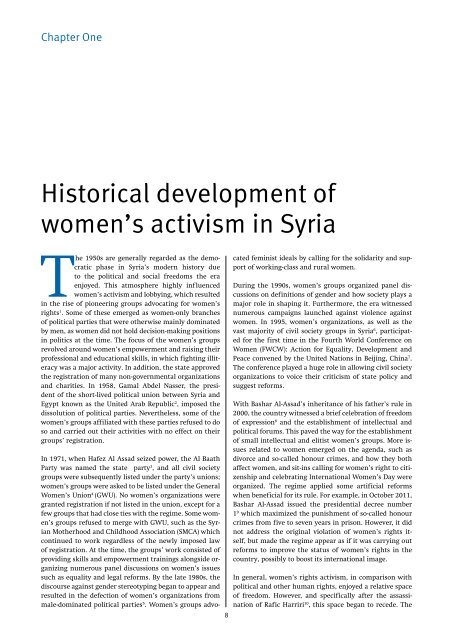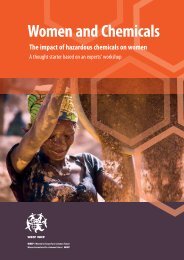future now”
YAO19
YAO19
Create successful ePaper yourself
Turn your PDF publications into a flip-book with our unique Google optimized e-Paper software.
Chapter One<br />
Historical development of<br />
women’s activism in Syria<br />
The 1950s are generally regarded as the democratic<br />
phase in Syria’s modern history due<br />
to the political and social freedoms the era<br />
enjoyed. This atmosphere highly influenced<br />
women’s activism and lobbying, which resulted<br />
in the rise of pioneering groups advocating for women’s<br />
rights 1 . Some of these emerged as women-only branches<br />
of political parties that were otherwise mainly dominated<br />
by men, as women did not hold decision-making positions<br />
in politics at the time. The focus of the women’s groups<br />
revolved around women’s empowerment and raising their<br />
professional and educational skills, in which fighting illiteracy<br />
was a major activity. In addition, the state approved<br />
the registration of many non-governmental organizations<br />
and charities. In 1958, Gamal Abdel Nasser, the president<br />
of the short-lived political union between Syria and<br />
Egypt known as the United Arab Republic 2 , imposed the<br />
dissolution of political parties. Nevertheless, some of the<br />
women’s groups affiliated with these parties refused to do<br />
so and carried out their activities with no effect on their<br />
groups’ registration.<br />
8<br />
In 1971, when Hafez Al Assad seized power, the Al Baath<br />
Party was named the state party 3 , and all civil society<br />
groups were subsequently listed under the party’s unions;<br />
women’s groups were asked to be listed under the General<br />
Women’s Union 4 (GWU). No women’s organizations were<br />
granted registration if not listed in the union, except for a<br />
few groups that had close ties with the regime. Some women’s<br />
groups refused to merge with GWU, such as the Syrian<br />
Motherhood and Childhood Association (SMCA) which<br />
continued to work regardless of the newly imposed law<br />
of registration. At the time, the groups’ work consisted of<br />
providing skills and empowerment trainings alongside organizing<br />
numerous panel discussions on women’s issues<br />
such as equality and legal reforms. By the late 1980s, the<br />
discourse against gender stereotyping began to appear and<br />
resulted in the defection of women’s organizations from<br />
male-dominated political parties 5 . Women’s groups advocated<br />
feminist ideals by calling for the solidarity and support<br />
of working-class and rural women.<br />
During the 1990s, women’s groups organized panel discussions<br />
on definitions of gender and how society plays a<br />
major role in shaping it. Furthermore, the era witnessed<br />
numerous campaigns launched against violence against<br />
women. In 1995, women’s organizations, as well as the<br />
vast majority of civil society groups in Syria 6 , participated<br />
for the first time in the Fourth World Conference on<br />
Women (FWCW): Action for Equality, Development and<br />
Peace convened by the United Nations in Beijing, China 7 .<br />
The conference played a huge role in allowing civil society<br />
organizations to voice their criticism of state policy and<br />
suggest reforms.<br />
With Bashar Al-Assad’s inheritance of his father’s rule in<br />
2000, the country witnessed a brief celebration of freedom<br />
of expression 8 and the establishment of intellectual and<br />
political forums. This paved the way for the establishment<br />
of small intellectual and elitist women’s groups. More issues<br />
related to women emerged on the agenda, such as<br />
divorce and so-called honour crimes, and how they both<br />
affect women, and sit-ins calling for women’s right to citizenship<br />
and celebrating International Women’s Day were<br />
organized. The regime applied some artificial reforms<br />
when beneficial for its rule. For example, in October 2011,<br />
Bashar Al-Assad issued the presidential decree number<br />
1 9 which maximized the punishment of so-called honour<br />
crimes from five to seven years in prison. However, it did<br />
not address the original violation of women’s rights itself,<br />
but made the regime appear as if it was carrying out<br />
reforms to improve the status of women’s rights in the<br />
country, possibly to boost its international image.<br />
In general, women’s rights activism, in comparison with<br />
political and other human rights, enjoyed a relative space<br />
of freedom. However, and specifically after the assassination<br />
of Rafic Harriri 10 , this space began to recede. The



